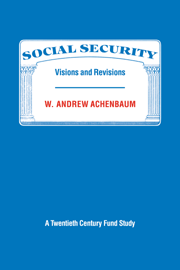Book contents
- Frontmatter
- Contents
- Dedication
- Foreword
- Acknowledgments
- Introduction
- Part I Social security comes of age
- 1 Social security: the early years
- 2 Social security matures, 1940–1972
- 3 The mid-life crisis of American social security
- 4 Social security gets a new lease on life
- Part II Current social security issues in historical perspective
- Notes
- Index
1 - Social security: the early years
Published online by Cambridge University Press: 04 August 2010
- Frontmatter
- Contents
- Dedication
- Foreword
- Acknowledgments
- Introduction
- Part I Social security comes of age
- 1 Social security: the early years
- 2 Social security matures, 1940–1972
- 3 The mid-life crisis of American social security
- 4 Social security gets a new lease on life
- Part II Current social security issues in historical perspective
- Notes
- Index
Summary
It took the Great Depression to launch social security in the United States. Every major European country had already embraced the logic of social insurance. But the rationale for a public income security program did not take root here until the Progressive period, when social insurance was promoted as a way to prevent and combat “the three fears” that plagued workers – unemployment, poverty in old age, and ill health. Social insurance proponents also sought to promote “social efficiency” – to advance the well-being of some of the nation's more vulnerable citizens without infringing on middle-class ideals of self-reliance and prudence.
Compulsory social insurance gained support among American Progressives, but it also met stiff opposition. Business associations worked tirelessly against old-age assistance and public retirement benefits, denouncing proposals for federal social insurance as “alien” to the American way of life. Union leaders advanced their own reasons for opposing social insurance. Grassroots labor organizations lobbied for old-age relief at the state level, but Samuel Gompers argued that a federal program would threaten the viability of trade-union pensions and divert attention from the need to increase wages and improve working conditions.
The Depression, however, made it clear that economic misfortune was not always the consequence of individual irresponsibility or failure of character. The notion that economic insecurity was a social risk predates the 1930s.
- Type
- Chapter
- Information
- Social SecurityVisions and Revisions: A Twentieth Century Fund Study, pp. 13 - 37Publisher: Cambridge University PressPrint publication year: 1986



